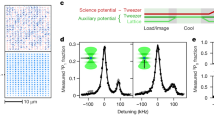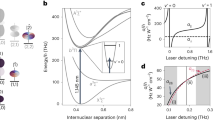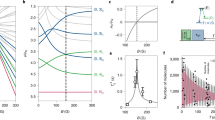Abstract
Atomic lattice clocks have spurred numerous ideas for tests of fundamental physics, detection of general relativistic effects and studies of interacting many-body systems. On the other hand, molecular structure and dynamics offer rich energy scales that are at the heart of new protocols in precision measurement and quantum information science. Here, we demonstrate a fundamentally distinct type of lattice clock that is based on vibrations in diatomic molecules, and present coherent Rabi oscillations between weakly and deeply bound molecules that persist for tens of milliseconds. This control is made possible by a state-insensitive magic lattice trap that weakly couples to molecular vibronic resonances and enhances the coherence time of light-induced clock state superpositions by several orders of magnitude. The achieved quality factor Q = 8 × 1011 results from 30 Hz narrow resonances for a 25 THz clock transition in Sr2 molecules. Our technique of extended coherent manipulation is applicable to long-term storage of quantum information in qubits based on ultracold polar molecules, while the vibrational clock enables precise probes of interatomic forces, tests of Newtonian gravitation at ultrashort range and model-independent searches for electron-to-proton mass ratio variations.
This is a preview of subscription content, access via your institution
Access options
Access Nature and 54 other Nature Portfolio journals
Get Nature+, our best-value online-access subscription
$29.99 / 30 days
cancel any time
Subscribe to this journal
Receive 12 print issues and online access
$209.00 per year
only $17.42 per issue
Buy this article
- Purchase on Springer Link
- Instant access to full article PDF
Prices may be subject to local taxes which are calculated during checkout




Similar content being viewed by others
Data availability
The data that support the plots within this paper and other findings of the study are available from the corresponding author upon reasonable request.
References
Moses, S. A., Covey, J. P., Miecnikowski, M. T., Jin, D. S. & Ye, J. New frontiers for quantum gases of polar molecules. Nat. Phys. 13, 13–20 (2017).
Barry, J. F., McCarron, D. J., Norrgard, E. B., Steinecker, M. H. & DeMille, D. Magneto-optical trapping of a diatomic molecule. Nature 512, 286–289 (2014).
Cairncross, W. B. et al. Precision measurement of the electron’s electric dipole moment using trapped molecular ions. Phys. Rev. Lett. 119, 153001 (2017).
Ospelkaus, S. et al. Quantum-state controlled chemical reactions of ultracold potassium–rubidium molecules. Science 327, 853–857 (2010).
McDonald, M. et al. Photodissociation of ultracold diatomic strontium molecules with quantum state control. Nature 534, 122–126 (2016).
Yan, B. et al. Observation of dipolar spin-exchange interactions with lattice-confined polar molecules. Nature 501, 521–525 (2013).
Park, J. W., Yan, Z. Z., Loh, H., Will, S. A. & Zwierlein, M. W. Second-scale nuclear spin coherence time of ultracold 23Na40K molecules. Science 357, 372–375 (2017).
Chou, C. et al. Preparation and coherent manipulation of pure quantum states of a single molecular ion. Nature 545, 203–207 (2017).
Campbell, S. L. et al. A Fermi-degenerate three-dimensional optical lattice clock. Science 358, 90–94 (2017).
McGrew, W. F. et al. Atomic clock performance enabling geodesy below the centimetre level. Nature 564, 87–90 (2018).
Nemitz, N. et al. Frequency ratio of Yb and Sr clocks with 5 × 10−17 uncertainty at 150 seconds averaging time. Nat. Photon. 10, 258–261 (2016).
Godun, R. M. et al. Frequency ratio of two optical clock transitions in 171Yb+ and constraints on the time variation of fundamental constants. Phys. Rev. Lett. 113, 210801 (2014).
Huntemann, N. et al. Improved limit on a temporal variation of m p/m e from comparisons of Yb+ and Cs atomic clocks. Phys. Rev. Lett. 113, 210802 (2014).
Chou, C. W., Hume, D. B., Rosenband, T. & Wineland, D. J. Optical clocks and relativity. Science 329, 1630–1633 (2010).
Kolkowitz, S. et al. Gravitational wave detection with optical lattice atomic clocks. Phys. Rev. D 94, 124043 (2016).
Kolkowitz, S. et al. Spin–orbit-coupled fermions in an optical lattice clock. Nature 542, 66–70 (2017).
Borkowski, M. Optical lattice clocks with weakly bound molecules. Phys. Rev. Lett. 120, 083202 (2018).
Zelevinsky, T., Kotochigova, S. & Ye, J. Precision test of mass-ratio variations with lattice-confined ultracold molecules. Phys. Rev. Lett. 100, 043201 (2008).
Schiller, S., Bakalov, D. & Korobov, V. I. Simplest molecules as candidates for precise optical clocks. Phys. Rev. Lett. 113, 023004 (2014).
Hanneke, D., Carollo, R. A. & Lane, D. A. High sensitivity to variation in the proton-to-electron mass ratio in \({\mathrm{O}}_{2}^{+}\). Phys. Rev. A 94, 050101(R) (2016).
Salumbides, E. J. et al. Bounds on fifth forces from precision measurements on molecules. Phys. Rev. D 87, 112008 (2013).
Salumbides, E. J., Dickenson, G. D., Ivanov, T. I. & Ubachs, W. QED effects in molecules: test of rotational quantum states of H2. Phys. Rev. Lett. 107, 043005 (2011).
Ye, J., Kimble, H. J. & Katori, H. Quantum state engineering and precision metrology using state-insensitive light traps. Science 320, 1734–1738 (2008).
McGuyer, B. H. et al. Precise study of asymptotic physics with subradiant ultracold molecules. Nat. Phys. 11, 32–36 (2015).
Kotochigova, S. & DeMille, D. Electric-field-dependent dynamic polarizability and state-insensitive conditions for optical trapping of diatomic polar molecules. Phys. Rev. A 82, 063421 (2010).
Neyenhuis, B. et al. Anisotropic polarizability of ultracold polar 40K87Rb molecules. Phys. Rev. Lett. 109, 230403 (2012).
Li, M., Petrov, A., Makrides, C., Tiesinga, E. & Kotochigova, S. Pendular trapping conditions for ultracold polar molecules enforced by external electric fields. Phys. Rev. A 95, 063422 (2017).
Rosenband, T., Grimes, D. G. & Ni, K.-K. Elliptical polarization for molecular stark shift compensation in deep optical traps. Opt. Express 26, 19821–19825 (2018).
Kajita, M., Gopakumar, G., Abe, M. & Hada, M. Elimination of the Stark shift from the vibrational transition frequency of optically trapped 174Yb6Li molecules. Phys. Rev. A 84, 022507 (2011).
Skomorowski, W., Pawłowski, F., Koch, C. P. & Moszynski, R. Rovibrational dynamics of the strontium molecule in the \({\mathrm{A}}^1\mathop {\sum}\nolimits_{u}^{+}\), \({\mathrm{c}}^3\mathop {\Pi}\nolimits_{\mathrm{u}}\) and \({\mathrm{A}}^1\mathop {\sum}\nolimits_{u}^{+}\) manifold from state-of-the-art ab initio calculations. J. Chem. Phys. 136, 194306 (2012).
Reinaudi, G., Osborn, C. B., McDonald, M., Kotochigova, S. & Zelevinsky, T. Optical production of stable ultracold 88Sr2 molecules. Phys. Rev. Lett. 109, 115303 (2012).
McDonald, M., McGuyer, B. H., Iwata, G. Z. & Zelevinsky, T. Thermometry via light shifts in optical lattices. Phys. Rev. Lett. 114, 023001 (2015).
McGuyer, B. H. et al. High-precision spectroscopy of ultracold molecules in an optical lattice. New J. Phys. 17, 055004 (2015).
Sobelman, I. I Atomic Spectra and Radiative Transitions (Springer, 1979).
Craig, D. P. & Thirunamachandran, T. Molecular Quantum Electrodynamics (Academic Press, 1984).
Acknowledgements
We acknowledge support from NSF grant no. PHY-1349725 and ONR grant no. N00014-17-1-2246, as well as Polish National Science Center grant no. 2016/20/W/ST4/00314.
Author information
Authors and Affiliations
Contributions
S.S.K., C.-H.L., K.H.L., C.L. and T.Z. designed and performed the experiments and interpreted the data. I.M. and R.M. carried out the theoretical analysis.
Corresponding author
Ethics declarations
Competing interests
The authors declare no competing interests.
Additional information
Peer review information: Nature Physics thanks David Leibrandt, Nicola Poli and the other, anonymous, reviewer(s) for their contribution to the peer review of this work.
Publisher’s note: Springer Nature remains neutral with regard to jurisdictional claims in published maps and institutional affiliations.
Supplementary information
Supplementary Information
Supplementary Figs. 1–3.
Rights and permissions
About this article
Cite this article
Kondov, S.S., Lee, CH., Leung, K.H. et al. Molecular lattice clock with long vibrational coherence. Nat. Phys. 15, 1118–1122 (2019). https://doi.org/10.1038/s41567-019-0632-3
Received:
Accepted:
Published:
Issue Date:
DOI: https://doi.org/10.1038/s41567-019-0632-3
This article is cited by
-
Second-scale rotational coherence and dipolar interactions in a gas of ultracold polar molecules
Nature Physics (2024)
-
An optical tweezer array of ultracold polyatomic molecules
Nature (2024)
-
Test of charged baryon interaction with high-resolution vibrational spectroscopy of molecular hydrogen ions
Nature Physics (2023)
-
Quantum register of fermion pairs
Nature (2022)
-
Absolute frequency metrology of buffer-gas-cooled molecular spectra at 1 kHz accuracy level
Nature Communications (2022)



